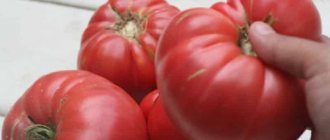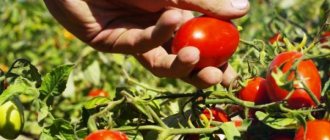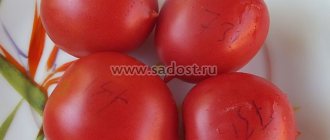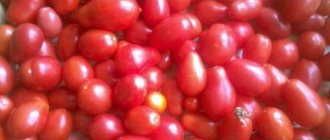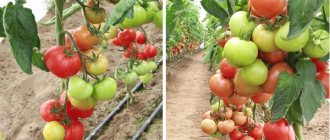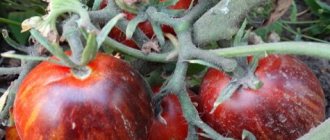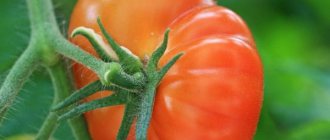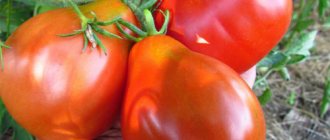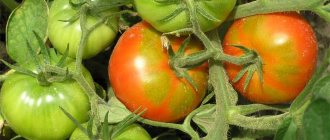Ephemeral tomatoes are perfect for canning, but are no less tasty when eaten fresh. The compact, dense fruits have versatile uses and are very easy to grow.
| Height | Landing location | Ripening time | Fruit color | Fruit size | Origin | Fruit shape |
| short | Open ground | Early ripening | Reds | Average | Variety | Round |
Description of the variety
Tomato "Ephemeral":
Fruit:
- They have a round shape;
- Unripe ones are light green in color; at the stage of technical ripeness they acquire a rich red color, without a green spot near the stalk;
- With dense, smooth, elastic skin;
- With juicy, sweet pulp, with a slight tomato sourness;
- Small in size.
The average weight is from 60 to 70 grams.
Bushes:
- Determinate type, compact, medium branched, with average formation of green mass;
- Short. They reach a height of 45 to 60 cm;
- The leaves are small, tomato-type, bright green in color, with a rough surface;
- The first inflorescence is formed after the 7th leaf, further ones at intervals of one leaf.
Description of the Ephemeral tomato and its characteristics, cultivation features
One of the most popular tomato varieties is the Ephemeral tomato. It has a number of positive qualities; what gardeners are most attracted to is its early ripening and versatility in preparation. This type of tomato has an excellent taste and aroma. He is completely unpretentious in care. The Ephemeral variety tolerates slight temperature changes and even drought.
But before purchasing tomato seeds or seedlings, you should still study information about the rules for growing and caring for this plant. After all, any vegetable crop may have its own characteristics, which you should know about in advance.
Characteristics and description
The Ephemeral tomato is an early variety, classified as determinant and unpretentious. Gardeners love this type of tomato due to its high yield. An adult bush can reach a height of 50 to 70 cm. Its dimensions are small, the trunk is fragile and fragile, and therefore needs a garter.
In order for the harvest to be early, tomatoes need to be pinched, but many gardeners prefer not to do this. The formation of inflorescences begins immediately above the 5th-7th leaf. Next, the ovary goes through each leaf. Externally, the bush has a normal shape, the foliage is dark green and fills the plant quite densely. Up to 7-8 bunches of fruit can ripen on one plant.
When purchasing seeds, you should pay attention to the packaging, which has a photo of a bush with ripe fruits, and on the back of the pack there is a brief description of the variety and recommendations for growing. The characteristic of the Ephemer variety has its own peculiarity: the plant is self-pollinating, which means that even in the rainiest season the bush will give a good harvest
On average, 7-8 kg can be collected from 1 m².
Description of tomatoes:
- The fruits of the tomato are small, round, and bright red in color.
- Quite dense, fleshy and tasty tomatoes are well suited for canning or making salads.
- The weight of one fruit can reach 80-100 g.
- The peel on the tomato is quite dense, which allows long-distance transportation of this vegetable.
- Ripe fruits can be stored for about 4 weeks in a cool and well-ventilated area.
Experts note that this variety has a high level of resistance to diseases, especially late blight.
The Ephemera tomato has many advantages, but it also has its disadvantages. For example, crops are often affected by a pest such as the Colorado potato beetle. In addition, the bushes require rationing of clusters with fruits, otherwise the yield and quality of the tomato will be reduced.
Growing and care
Before planting, the seeds must be properly prepared. To do this, many gardeners use a weak solution of manganese and a growth activator. The first allows you to avoid the appearance of fungus and many pests in the future, and the second solution promotes faster growth and development of the plant.
Sowing of seedlings is carried out at the end of March or beginning of April. The seeds are planted in a special container with pre-prepared fertilized soil.
Gardeners cover the planting material with film, but in this case it is extremely important to ventilate every day so that excess moisture does not accumulate. As soon as 2 leaves appear on the sprouts, you can start picking
The Ephemera tomato is grown both in open ground and in greenhouses and greenhouses. Seedlings are planted in a permanent place in April or May; no more than 7-9 sprouts should be planted per 1 m². On average, 80-90 days should pass from the time the seeds are sown until the harvest. A characteristic feature of early ripening varieties is that when pinched, the spent sprouts can be used as seedlings.
The first harvest can be harvested as early as June and the harvest can continue until September. The fruits ripen at the same time, which makes harvesting much easier.
It is not difficult to care for this crop, especially since the variety is unpretentious and hardy. It is worth watering the bushes in the early morning or evening.
It is important to monitor the condition of the soil and prevent cracking of the ground
Ephemera requires regular loosening of the soil; it is best if mulching is done during planting. It is worth fertilizing with complex minerals. The first time during planting, and the second during the formation of inflorescences.
It has a good taste and versatility in use, as it is great for canning, making pasta or juice.
Tomato: advantages and disadvantages
The main advantages of the tomato variety “Ephemer” include:
- High germination of seed material;
- Resistance to weather changes;
- Early ripening;
Among the minor disadvantages, one can highlight the susceptibility of young seedlings to attacks by Colorado potato beetles.
- Friendly return of fruits;
- Commercial appearance;
- High taste characteristics;
- Possibility of obtaining two harvests per season;
- No need for pinching and shaping;
- Excellent immunity to most tomato diseases;
- Universal purpose of fruits;
- Immunity to fruit cracking;
- Excellent keeping quality and transportability.
Advantages and disadvantages
Let's consider the main advantages of the variety:
- planting material germinates in almost 100% of cases;
- fruits ripen early;
- excellent taste;
- can be transported over long distances;
- tomatoes ripen at the same time, which facilitates the harvesting process;
- the bushes do not need to be pinched, tied up, or shaped;
- the plant is resistant to most diseases.
As for the disadvantages, this variety is loved by Colorado potato beetles, so the gardener must prepare for pest control. The brushes must be normalized, otherwise the tomatoes will be small, due to the fact that the plant cannot provide a large number of berries with nutrients.
tomato Eldorado - description and characteristics of the variety
Growing tomatoes
The "Ephemeral" tomato can be cultivated both without seedlings (in greenhouse conditions) and in seedlings.
How to prepare seeds?
Description:
- To disinfect seed material, use a weak manganese solution. Thanks to this, stable immunity to most diseases that affect young shoots is developed;
- To obtain strong, strong seedlings, the seeds are treated with growth stimulants.
Sowing seed material
Description:
- Sowing begins in late March-early April;
- To avoid picking in the future, it is advisable to sow the seeds in a separate container. But if this is not possible, you can use a common container filled with fertile soil, which contains humus, turf soil and peat. Organic and mineral fertilizers must be added to the substrate and moistened abundantly;
If there is heavy soil, it is necessary to add river sand.
- Sowing is carried out in shallow furrows with an interval of 2 cm. The top is sprinkled with soil and irrigated;
- It is recommended to cover the container with a film cover. until the sprouts hatch and place in a warm (up to +28 degrees) and well-lit room;
- The greenhouse effect created under the film contributes to increased humidity. To prevent the occurrence of fungal diseases, the film is regularly raised to ventilate the plantings;
- In the phase of the first true leaves, the seedlings are planted in separate cups. This way, each shoot will be provided with the optimal amount of nutrition, space and light;
- After picking, feed 1-2 times, adding liquid complex fertilizer.
Rules for planting seedlings
Description:
- In the second or third decade of May, the seedlings can be transplanted to a permanent place in open ground. At the time of planting, the age of the seedlings should be from 55 to 70 days and have from 4 to 6 full leaves;
- Tomatoes prefer light and fertile soil, so when preparing the beds, humus and superphosphate are added to the soil;
- When planting, maintain a distance between seedlings of 40 to 45 cm. Recommended density is from 7 to 9 bushes per 1 m2.
Description of the hybrid early-ripening tomato Brother 2 and recommendations for growing
Tomato Brother 2 F1 belongs to the hybrid varieties of the Siberian collection. It meets all the requirements of vegetable growers regarding this crop. This variety can be grown in open ground, under film covering, and also in a greenhouse. The fruits are large, fleshy and tasty. The yield is quite high.
What is a Brother 2 tomato?
Description and characteristics of the variety:
- Tomato Brother 2 is a universal variety, suitable for both fresh consumption and winter storage.
- It belongs to the early ripening fruits. The harvest ripens in 100-110 days.
- Up to 18 kg of tomatoes ripen per 1 m².
- Bushes of determinant type, the average height of which is 90-120 cm.
- The first inflorescence appears above the 5th or 6th leaf, and the subsequent ones after it, after every 2nd leaf.
- Each inflorescence or cluster bears 5-6 fruits.
- The weight of one tomato is from 180 to 250 g.
- Tomatoes have a bright crimson color. The shape is round.
- The elastic skin protects the fruits from cracking and deformation, so they can be transported over long distances.
- The inside of the tomatoes is fleshy and dense.
How to grow tomatoes?
A shallow box filled with soil is ideal for sowing. Grooves 1 cm deep are made in it. It is recommended to use tweezers to place the grains. The seeds are covered with a thin layer of soil and sprayed with water from a spray bottle.
To create a greenhouse effect and speed up the germination process, the box is covered with glass or film. Place the container in a warm place where the temperature is maintained at +25°C.
When seedlings begin to appear above the soil surface, the covering is removed and the container is moved to a bright place (but not under the sun's rays). Approximately 10 days after sowing, the plant is fertilized with a solution of nitrate and calcium. After the formation of 2-3 leaves, picking is carried out.
Seedlings transplanted into separate containers grow better and become stronger. At the initial stage, the root system actively develops. The stronger and healthier the roots, the better the bush will bear fruit. After picking (approximately 2 weeks), the seedlings can be fed with sodium-potassium fertilizer.
2 months after planting, the seedlings are prepared for transplanting into the ground. Preparation consists of hardening. The site for the Bratishka tomato is prepared long before planting. Choose land on which vegetable crops such as potatoes, turnips, eggplants, peas and tomatoes did not grow.
The soil after them is depleted, as they draw all the nutrients from it. The place should be bright, but protected from direct exposure to ultraviolet rays. The land must be plowed and rendered harmless.
When planting, maintain a distance of at least 40-50 cm between seedlings. The depth should correspond to the length of the roots. Caring for bushes in the ground consists of periodically loosening the soil, weeding, hilling, watering, feeding and shaping.
It is advisable to cultivate the soil after watering. Loosening ennobles the roots, and after it the drainage function of the soil improves. During weeding, weeds are removed, which take away nutrients and strength from the roots. Hilling maintains soil moisture. All of the above actions are very important for the plant, they increase productivity and contribute to the normal development of fruits.
Reviews from gardeners about the variety are positive. People describe the excellent taste of tomatoes, talk about the plant’s unpretentiousness and resistance to disease. There is another positive feature - the bushes bear fruit in all weather conditions and in areas with low air temperatures. For many regions of our country this is a very important feature.
Bush care
Care measures:
- The frequency of watering is 2-3 times a week. Warm water is recommended for irrigation. Water directly under the bush, without getting water on the stems, foliage and fruits;
- At the end of each watering, the soil under the bushes and between the rows is loosened to avoid compaction, which can lead to poor penetration of air moisture to depth;
- Be sure to mulch the soil with sawdust, straw or mown grass, in a layer of 5-7 cm. Thanks to this, the moisture will not evaporate quickly, the root system will be protected from overheating, and weeds will also stop growing;
- Throughout the growing season, they are fed with various nutritional mixtures, which contribute to earlier ripening of the fruits. Immediately after planting, a solution of mullein or humus is added to the soil, since they contain nitrogen, which has a beneficial effect on plant growth and the growth of green mass. Tomatoes are very responsive to “green” fertilizers: infusions of nettles or freshly cut grass;
During flowering and fruiting, mineral fertilizers enriched with phosphorus and potassium are applied, thanks to which beautiful fruits with a rich, bright taste are formed.
- Due to the not very strong pole, the bushes need tying to prevent branches from breaking off.
Tomato Ephemeral F1 20 seeds
varietal tomato seeds Ephemeral F1
Ukraine
Order form for bulk purchases of seeds
Quantity: Pack of 20 seeds
Tomato Ephemera F1
Tomato "Ephemeral" F1. An extra-early, parthenocarpic tomato variety (fruits set without pollination in any weather), for cultivation in open and closed ground. Grown by seedlings and without seedlings. From germination to the first harvest - 78-83 days. The bush is low, 40-50 cm, ordinary. The fruits are red, round, weighing 80 - 100 g, hard, fleshy, with high taste, transportable, with a friendly yield. The variety is resistant to diseases! A unique opportunity to get two harvests in one season!!
Economy package weighing 20 seeds
Wholesale and retail price
To get a good harvest of tomatoes, it is important to strictly follow the agricultural techniques for growing them. Our recommendations will help you with this:. You can plant tomatoes in their original place no earlier than after 2-3 years.
When growing tomatoes, do not use fresh manure, otherwise the plants will become fattened: rapid growth of stepsons will begin, very large leaves will appear, the stems will thicken, and the fruits will set poorly and grow slowly
You can plant tomatoes in their original place no earlier than after 2-3 years. When growing tomatoes, do not use fresh manure, otherwise the plants will become fattened: the shoots will begin to grow rapidly, very large leaves will appear, the stems will thicken, and the fruits will set poorly and grow slowly.
Some gardeners break off leaves on plants to increase yield. There is no need to get carried away with this technique, especially when growing tomatoes in a greenhouse or greenhouse. The leaves provide nutrients to the fruit, so during plant growth, try to remove only diseased and yellow foliage. When the fruits on the first lower cluster are completely filled, that is, they reach the size characteristic of this variety, the leaves under the cluster can be removed.
So gradually, as the tomatoes ripen, remove the leaves under each ripe cluster, but no more than 2-3 leaves per week from one plant. In addition, do not forget to temporarily remove the stepsons, otherwise you will lose part of the harvest. If the weather is cloudy during flowering, the fruits do not set well. This is because the pollen becomes sticky and incapable of pollination.
For better fruit set, spray the plants with a 0.02 percent solution of boric acid (2 g per 10 liters of water), using this amount per 100 square meters. m landings. If the weather does not improve, repeat spraying after 2-3 days.
Water the tomatoes rarely but generously. They love hilling and regular loosening of the soil between the rows: without this, the roots cannot actively work and deliver food and water for growth, plant development and fruit formation.
When growing tomatoes in a greenhouse, remember that temperatures above 32 degrees are detrimental to them. From the heat, leaves begin to curl, flowers and ovaries fall off. Therefore, monitor the air temperature in the greenhouse and ventilate it if necessary.
Light, highly fertile soils are suitable for cultivation. Good predecessors are cucumbers, cabbage, legumes, onions, carrots. Seeds for seedlings are sown at the end of March - beginning of April to a depth of 2-3 cm. Before sowing, the seeds are treated in potassium permanganate and washed with clean water. Picking - in the phase of 1-2 true leaves. Seedlings are fed 2-3 times with complete fertilizer. 7-10 days before planting, seedlings begin to harden. Seedlings are planted in open ground at the age of 55-70 days, when the threat of frost has passed (for the Non-Black Earth zone - June 5-10), and when using temporary film shelters - a little earlier (May 15-20). Planting pattern 70x30 - 40 cm. As they grow, the plants are formed into one stem and tied to a vertical or horizontal trellis. Subsequently, the plants are watered regularly. Warm water is used for irrigation. During the growing season, 2-3 plant feedings are used.
Reviews about the variety from those who planted
Good tolerance to cold snaps and dry periods, combined with a guaranteed good harvest, has made the “Ephemer” tomato in demand among gardeners living in unfavorable climatic conditions. Due to the presence of a large number of advantages, more and more owners of household plots are showing interest in the “Ephemer” tomato variety. It captivated us with its early ripening and ease of care, which is why many gardeners remain devoted to the variety from year to year. Review from a gardener:
Characteristics
The tomato variety is considered early due to the fact that a maximum of 3 months passes from the moment the first shoots appear until the harvest. The plant type is determinate, i.e. bushes grow strictly to a set height, and stepsons are formed extremely rarely.
Ephemeral tomatoes are common in Russia and Ukraine; the plant is unpretentious: even during the period when the fruits are ripening, they do not need a large amount of light and heat. This factor attracts many gardeners - even with temperature fluctuations, heavy rains or drought, you can get an excellent harvest. Seeds germinate in 99% of cases.
The bushes are low, compact, the shoots are powerful, their maximum height is 70 cm, the plant does not branch much. The foliage is painted a lush green color. Each bush can ripen about 8 clusters, each of which will contain tomatoes.
The color of the tomatoes is bright red, they are small, about 65 grams. They have a dense skin, and the pulp is juicy, has a characteristic tomato flavor, and the fruits are sweet and sour. Even ripe berries do not crack, due to which they can be transported even over long distances without fear.
You can store vegetables for about 2 months, but it is important to create certain conditions: place the fruits in a dark, dry and cool place. They are also popular due to their versatility: they can be canned, freshly sliced, a variety of pickles and tomato juice.
tomato Elf - description and characteristics of the variety
